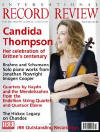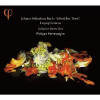Texte paru dans: / Appeared in:
*

International Record Review - (03/2013)
Pour
s'abonner / Subscription information
PHI
LPH006

5400439000063 (ID280)
Consultez toutes les évaluations recensées pour ce cd
~~~~ Reach all the evaluations located for this CD
As part of his continuing and occasional series of Bach cantata recordings , Philippe Herreweghe now performs four works from Bach’s first Leipzig cycle. All were written between late July and early September 172 3 and are works of surpassing richness, sophistication and maturity. There are many structural similarities between them, but even more diversity in terms of instrumentation, mood and use of techniques such as chromaticism and polyphony. As always with Bach’s sacred cantatas, they are profoundly uned to the theologically rich texts. Bach’s musico-dramatic presentation of the Lutheran faith neither shies away from the sometime anguish of the believer (‘Wie zittern und wanken’ from BWV105) nor the intensely personal relationship between the Christian and Redeemer (‘Doch Jesus wi1l auch bei der Strafe’ from BWV46).
All four cantatas open with a substantial and magnificent chorus, each quite unlike the other. Similarly, all end with fairly shorter chorales — again all unique in style. My favourite is the opening chorus to BWV46, which begins with a slow and fairly simple statement of the chorale theme (simple by Bach’s standards anyway), but with anxious orchestral accompaniment hinting at drama to come. Then about two thirds along, it breaks into a vocal and instrumental fugue of almost ferocious strength. In all four cantatas, there are arias of spellbinding beauty. To mention but two: the radiant aria for soprano, three recorders, two oboes and strings in BWV25, ‘Offne meinen schlechten Leidern’; and the exultant duet for tenor and ‘corno da tirasi’ in BWV105, ‘Kann ich nur Jesum mir zum Freunde machen’.
Now what is a ‘corno da tirasi’? No one seems quite sure. No instrument by that name seems to have survived. Some think it is the same instrument as the ‘tromba da tirasi’, or slide trumpet. Others claim they are different. On his earlier recording of this cantata, Herreweghe ducked the question by playing the solo part on an oboe (and making no mention of the fact in the notes). For his cantata series on BIS, Masaaki Suzuki’s trumpeter, Toshio Shimada, constructed an instrument which combines a natural horn and sliding mechanism. However, Suzuki openly admits that this solved only some of the musical problems. In his new recording, neither Herreweghe nor his booklet author, the great Bach scholar Christoph Wolff, discusses the issue. However, they must consider them distinct instruments, for the same player, Alain de Rudder, plays tromba da tirasi in BWV46 and a corno da tirasi in BWV105. They do in fact sound quite different in their respective solos; but what design of instrument de Rudder is playing is unclear.
While on matters of historical authenticity, I must point out these performances use a small chamber choir and eschew the radical one voice per part approach, about which Wolff is very sceptical. With a choir as supple and disbplined as Collegium Vocale Gent, or indeed Bach Collegium Japan, should anyone except diehard purists really care? As an assiduous collector of both their cantata series, I obviously do not shun traditional ‘choral’ versions. However, recent recordings by Sigiswald Kuijken, Eric Milnes and others reveal how much one-voice-per part performance can offer, with very little lost in exchange. (In this connection, I digress slightly to recommend an extraordinary new recording of the first half of the Christmas Oratorio on Rondeau with only four singers, one of whom is a boy soprano.) Normally, I am more than happy to enjoy choral performances such as Herreweghe’s on their own terms; but more than once listening to this disc, I wondered how much better the choruses and chorales might sound with just solo voices.
The opening chorus to BWV25 is a work of dazzling complexity, richness and invention. Collegium Vocale and Herreweghe handle it superbly; however, something seemed slightly wrong with the balance in the multiplicity of vocal and instrumental parts. I wonder if single voices would have been the solution. For different reasons, the same question arises in respect of the opening three movements of BWV138 replete with dissonance and chromaticism where soloists’ recitatives alternate with the choir ? Does it make more musical sense for these solo voices to move in and out of a choir of just four singers? Kuijken’s one-voice-per-part recording, although hampered by an inadequate tenor, suggests that it does.
A master Bach interpreter, Herreweghe cherishes the intimate and expounds the monumental in these works, but always without exaggeration. One could scarcely imagine four better soloists than these. The talents of Hana B1ažiková, Damien Guillon and the ageless veteran Peter Kooij (formerly spelt ‘Kooy’) will be well known to Bach lovers and they are all outstanding here, surpassing even the strong casts on the comparison recordings. For me, the real surprise of the recording was the tenor Thomas Hobbs. As can be heard in his aria in BWV105, ‘Kann ich nur Jesum mir zum Freunde machen’, his pure tone, full of youthful ardour, and his assured technique are ideal for Bach. The chorus and orchestra of Collegium Vocale are also spectacularly good in this rich and demanding music. Special praise goes to the Baroque oboist Marcel Ponseele, who also played the solos in Herreweghe’s 1990 recording of BWV 105 and is even better now.
For all except one-voice-per-part absolutists, this must
rank as good a recording of Bach cantatas as has ever been made.
Fermer la fenêtre/Close window
Cliquez l'un ou l'autre
bouton pour découvrir bien d'autres critiques de CD
Click either button for many other reviews


